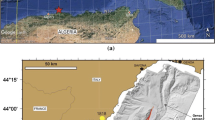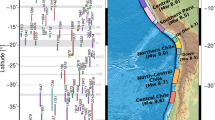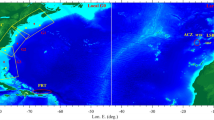Abstract
Since the devastating earthquake of 2010 in Haiti, significant efforts have been devoted to estimating future seismic and tsunami hazard in Hispaniola. In 2013, following a workshop of experts, UNESCO commissioned an initial modeling study to assess tsunami hazard, essentially from seismic sources, along the North shore of Hispaniola (NSOH), which is shared by the Republic of Haiti (RH) and the Dominican Republic (DR). The scope of this study included detailed tsunami inundation mapping for two selected critical sites, Cap Haitien in RH and Puerto Plata in DR. Results of this effort are reported here, and, although still limited in scope, they are within the framework and contribute to the advancement of the UNESCO IOC Tsunami and other Coastal Hazards Warning System for the Caribbean and Adjacent Regions (CARIBE EWS; von Hillebrandt-Andrade in Science 341:966–968, 2013). In similar work done for critical areas of the US east coast (under the auspice of the US National Tsunami Hazard Mitigation Program), the authors have modeled the most extreme far-field tsunami sources in the Atlantic Ocean basin, including: (1) a hypothetical \(M_w\) 9 seismic event in the Puerto Rico Trench (PRT); (2) a repeat of the historical 1755 \(M_w\) 9 earthquake in the Azores convergence zone (LSB); and (3) a hypothetical extreme \(450\,\hbox {km}^3\) flank collapse of the Cumbre Vieja Volcano (CVV) in the Canary Archipelago. Here, tsunami hazard assessment is performed along the NSOH for these three sources, plus two additional near-field coseismic tsunami sources: (1) a \(M_w\) 8 earthquake in the western segments of the nearshore Septentrional fault (SF), as a repeat of the 1842 event; and (2) a \(M_w\) 8.7 earthquake occurring in selected segments of the North Hispaniola Thrust Fault (NHTF). Initial tsunami elevations are modeled based on each source’s parameters and propagated with FUNWAVE-TVD (a nonlinear and dispersive long-wave Boussinesq model) in a series of increasingly fine-resolution nested grids (from 1 arc-min to 205 m) using a one-way coupling methodology. For the two selected sites, coastal inundation is computed with TELEMAC (a Nonlinear Shallow Water wave model), in finer-resolution (12–30 m) unstructured nested grids. While for the EC, PRT is a far-field source, for RH and DR, this would be local source as some of the NSOH would be affected within 1 h or is within 200 km of the PRT. This is per definitions of UNESCO IOC. Regional goes from 200 to 1000 km and within 1 and 3 h, and distant is greater than 3 h and more than 1000 km. We find that among the far-field sources CVV causes the largest impact, with up to 20-m runup at the critical sites while PRT, which is a local source for the NSOH, only causes up to 4-m runup due to its directionality; PRT, however, has both a much shorter return period and would impact the NSOH within 30 min of the earthquake. Among near-field sources, the SF event, as could be expected from a strike-slip fault, only causes a small tsunami, but the NHTF event causes up to 12-m runup in the critical sites, with the tsunami arriving within minutes of the earthquake. Hence, the latter event can be considered as the “Probable Maximum Tsunami” (PMT; following, e.g., the US Nuclear Regulatory Commission terminology) for the NSOH. Results of detailed coastal modeling for this PMT can be used to develop maps of vulnerability for the critical sites and prepare for mitigating measures and evacuation; a few examples of such maps are given in the paper. Although a number of earlier studies have dealt with each of the far-field tsunami sources, the modeling of their impact on the NSOH and that of the near-field sources, presented here as part of a comprehensive tsunami hazard assessment study, are novel. Future work should model additional coastal sites and may consider effects of tsunamis generated by near-field submarine mass failures.
















Similar content being viewed by others
References
Abadie S, Morichon D, Grilli ST, Glockner S (2010) Numerical simulation of waves generated by landslides using a multiple-fluid Navier–Stokes model. Coast Eng 57:779–794. doi:10.1016/j.coastaleng.2010.03.003
Abadie S, Harris JC, Grilli ST, Fabre R (2012) Numerical modeling of tsunami waves generated by the flank collapse of the Cumbre Vieja Volcano (La Palma, Canary Islands): tsunami source and near field effects. J Geophys Res 117:C05030. doi:10.1029/2011JC007646
Baptista MA, Heitor S, Miranda JM, Miranda PMA, Mendes Victor L (1998a) The 1755 Lisbon earthquake; evaluation of the tsunami parameters. J Geodyn 25:143–157
Baptista MA, Heitor S, Miranda JM, Miranda PMA, Mendes Victor L (1998b) Constraints on the source of the 1755 Lisbon tsunami inferred from numerical modeling of historical data on the source of the 1755 Lisbon tsunami. J Geodyn 25:159–174
Baptista MA, Miranda JM, Chierici F, Zitellini N (2003) New study of the 1755 earthquake source based on multi-channel seismic survey data and tsunami modeling. Nat Hazards Earth Syst Sci 3:333–340
Barkan R, ten Brick US, Lin J (2009) Far field tsunami simulations of the 1755 Lisbon earthquake: implication for tsunami hazard to the US East Coast and the Caribbean. Mar Geol 264:109–122
Benford B, DeMets C, Calais E (2012) GPS estimates of microplate motions, northern Caribbean: evidence for a Hispaniola microplate and implications for earthquake hazard. Geophys J Int 191(2):481–490. doi:10.1111/j.1365-246X.2012.05662.x
Calais E, Mercier de Lepinay B (1995) Strike-slip tectonic processes in the northern Caribbean between Cuba and Hispaniola (Windward Passage). Mar Geophys Res 17(1):63–95
Calais E, Freed A, Mattioli G, Amelung F, Jónsson S, Jansma P, Hong S-H, Dixon T, Prépetit C, Momplaisir R (2010) Transpressional rupture of an unmapped fault during the 2010 Haiti earthquake. Nat Geosci 3(11):749–799. doi:10.1038/NGEO992
Corral Á (2006) Dependence of earthquake recurrence times and independence of magnitudes on seismicity history. Tectonophysics 424(3):177–193. doi:10.1016/j.tecto.2006.03.035
Day SJ, Watts P, Grilli ST, Kirby JT (2005) Mechanical models of the 1975 Kalapana, Hawaii earthquake and tsunami. Mar Geol 215:59–92. doi:10.1016/j.margeo.2004.11.008
Dolan JE, Wald DJ (1998) The 1943–1953 north-central Caribbean earthquakes: active tectonic setting, seismic hazards, and implications for Caribbean-North America plate motions. Special papers-geological Society of America, 143–169
Fritz HM, Hillaire JV, Molire E, Wei Y, Mohammed F (2013) Twin tsunamis triggered by the 12 January 2010 Haiti earthquake. Pure Appl Geophys 170(9–10):1463–1474. doi:10.1007/s00024-012-0479-3
Gailler A, Calais E, Hébert H, Roy C, Okal E (2015) Tsunami scenarios and hazard assessment along the northern coast of Haiti. Geophys J Int 203(3):2287–2302. doi:10.1093/gji/ggv428
Geist E, Lynett P, Chaytor J (2009) Hydrodynamic modeling of tsunamis from the Currituck landslide. Mar Geol 264:41–52. doi:10.1016/j.margeo.2008.09.005
Gica E, Spillane MC, Titov VV, Chamberlin CD, Newman J (2008) Development of the forecast propagation database for NOAAs Short-term inundation forecast for tsunamis. NOAA Tech. Memo. OAR PMEL-139
Glimsdal S, Pedersen GK, Harbitz CB, Løvholt F (2013) Dispersion of tsunamis: Does it really matter? Nat Hazards Earth Syst Sci 13:1507–1526. doi:10.5194/nhess-13-1507-2013
Grilli AR, Grilli ST (2013a) Modeling of tsunami generation, propagation and regional impact along the US East Coast from the Azores Convergence Zone. Research report no. CACR-13-04, 20 pps. http://personal.egr.uri.edu/grilli//grilli-grilli-cacr-13-04
Grilli AR, Grilli ST (2013b) Modeling of tsunami generation, propagation and regional impact along the upper US East coast from the Puerto Rico trench. Research Report no. CACR-13-02, 18 pps. http://personal.egr.uri.edu/grilli//grilli-grilli-cacr-13-02
Grilli ST, Ioualalen M, Asavanant J, Shi F, Kirby JT, Watts P (2007) Source constraints and model simulation of the December 26, 2004 Indian Ocean tsunami. J Waterw Port Coast Ocean Eng 33:414–428
Grilli ST, Dubosq S, Pophet N, Pérignon Y, Kirby JT, Shi F (2010) Numerical simulation and first-order hazard analysis of large co-seismic tsunamis generated in the Puerto Rico thrench: near-field impact on the North shore of Puerto Rico and far-field impact on the US East Coast. Nat Hazards Earth Syst Sci 10:2109–2125. doi:10.5194/nhess-2109-2010
Grilli ST, Harris JC, Tajalibakhsh T, Masterlark TL, Kyriakopoulos C, Kirby JT, Shi F (2013c) Numerical simulation of the 2011 Tohoku tsunami based on a new transient FEM co-seismic source: comparison to far- and near-field observations. Pure Appl Geophys 170:1333–1359. doi:10.1007/s00024-012-0528-y
Grilli ST, O’Reilly C, Harris JC, Tajalli-Bakhsh T, Tehranirad B, Banihashemi S, Kirby JT, Baxter CDP, Eggeling T, Ma G, Shi F (2015a) Modeling of SMF tsunami hazard along the upper US East Coast: detailed impact around Ocean City, MD. Nat Hazards 76(2):705–746. doi:10.1007/s11069-014-1522-8
Grilli ST, Grilli AR, Tehranirad B, Kirby JT (2015b) Modeling tsunami sources and their propagation in the Atlantic Ocean for coastal tsunami hazard assessment and inundation mapping along the US East Coast. In: Proceedings of the 2015 COPRI Solutions to Coastal Disasters Conference, (Boston, USA. September 9–11, 2015), American Soc. Civil Eng., 12 pps. (in press)
Hayes GP, Briggs RW, Sladen A, Fielding EJ, Prentice C, Hudnut K, Simons M (2010) Complex rupture during the 12 January 2010 Haiti earthquake. Nat Geosci 3(11):800–805. doi:10.1038/NGEO977
Harbitz CB, Glimsdal S, Bazin S, Zamora N, Lovholt F, Bungum H, Smebye H, Gauer P, Kjekstad O (2012) Tsunami hazard in the Caribbean: regional exposure derived from credible worst case scenarios. Cont Shelf Res 8:1–23. doi:10.1016/j.csr.2012.02.006
Hervouet JM (2007) Hydrodynamics of free surface flows: modeling with the finite element method. Wiley, Colorado, p 360
Hornbach MJ, Braudy N, Briggs RW, Cormier MH, Davis MB, Diebold JB, Johnson III HE (2010) High tsunami frequency as a result of combined strike-slip faulting and coastal landslides. Nature Geoscience. doi:10.1038/ngeo975
IOC (Intergovernmental Oceanographic Commission) (2013) Exercise Caribe Wave/Lantex 14. A Caribbean and Northwestern Atlantic Tsunami Warning Exercise, 26 March 2014. Volume 1: Participant Handbook, IOC Technical Series, 109 vol. 1. Paris: UNESCO
IOC (Intergovernmental Oceanographic Commission) (2015) Intergovernmental Coordination Group for the Tsunami and other Coastal Hazards Warning System for the Caribbean and Adjacent Regions (ICG/CARIBE-EWS). Tenth Session, Paris: UNESCO
López-Venegas AM, Horrillo J, Pampell-Manis A, Huérfano V, Mercado A (2015) Advanced tsunami numerical simulations and energy considerations by use of 3D2D coupled models: the October 11, 1918 Mona passage tsunami. Pure Appl Geophys 172(6):1679–1698. doi:10.1007/s00024-014-0988-3
Ioualalen M, Asavanant J, Kaewbanjak N, Grilli ST, Kirby JT, Watts P (2007) Modeling the 26th December 2004 Indian Ocean tsunami: case study of impact in Thailand. J Geophys Res 112:C07024. doi:10.1029/2006JC003850
Kirby JT, Shi F, Tehranirad B, Harris JC, Grilli ST (2013) Dispersive tsunami waves in the ocean: model equations and sensitivity to dispersion and Coriolis effects. Ocean Modell 62:39–55. doi:10.1016/j.ocemod.2012.11.009
Knight B (2006) Model predictions of Gulf and Atlantic coast tsunami impacts from a distribution of sources. Sci Tsunami Hazards 24(5):304–312
Lander JF (1997) Caribbean tsunamis: an initial history. Nat Hazards 3:1–18
Madsen PA, Fuhrman DR, Schaffer HA (2008) On the solitary wave paradigm for tsunamis. J Geophys Res 113:C12012
McMurtry GM, Tappin DR, Sedwick PN, Wilkinson I, Fietzke J, Sellwood B (2007) Elevated marine deposits in Bermuda record a late Quaternary megatsunami. Sediment Geol 200(3–4):155–165. doi:10.1016/j.sedgeo.2006.10.009
Okada Y (1985) Surface deformation due to shear and tensile faults in a half space. Bull Seismol Soc Am 75(4):1135–1154
Ramalho RS, Winckler G, Madeira J, Helffrich GR, Hiplito A, Quartau R, Adena K, Schaefer JM (2015) Hazard potential of volcanic flank collapses raised by new megatsunami evidence. Sci Adv 1(9):e1500456
Shi F, Kirby JT, Harris JC, Geiman JD, Grilli ST (2012) A high-order adaptive time-stepping TVD solver for Boussinesq modeling of breaking waves and coastal inundation. Ocean Modell 43–44:36–51. doi:10.1016/j.ocemod.2011.12.004
Shimozono T, Cui H, Pietrzak JD, Fritz HM, Okayasu A, Hooper AJ (2014) Short wave amplification and extreme runup by the 2011 Tohoku tsunami. Pure Appl Geophys 171(12):3217–3228. doi:10.1007/s00024-014-0803-1
Tappin DR, Watts P, Grilli ST (2008) The Papua New Guinea tsunami of 1998: anatomy of a catastrophic event. Nat Hazards Earth Syst Sci 8:243–266
Tappin DR, Grilli ST, Harris JC, Geller RJ, Masterlark T, Kirby JT, Shi F, Ma G, Thingbaijamg KKS, Maig PM (2014) Did a submarine landslide contribute to the 2011 Tohoku tsunami ? Mar Geol 357:344–361. doi:10.1016/j.margeo.2014.09.043
Tehranirad B, Shi F, Kirby JT, Harris JC, Grilli ST (2011) Tsunami benchmark results for fully nonlinear Boussinesq wave model FUNWAVE-TVD, Version 1.0. Technical report, No. CACR-11-02, Center for Applied Coastal Research, University of Delaware
Tehranirad B, Harris JC, Grilli AR, Grilli ST, Abadie S, Kirby JT, Shi F (2015) Far-field tsunami hazard in the north Atlantic basin from large scale flank collapses of the Cumbre Vieja volcano, La Palma. Pure Appl Geophys 172(12):3,589–3,616. doi:10.1007/s00024-015-1135-5
ten Brink U, Twichell D, Geist E, Chaytor J, Locat J, Lee H, Buczkowski B, Barkan R, Solow A, Andrews B, Parsons T, Lynett P, Lin J, Sansoucy M (2008) Evaluation of tsunami sources with the potential to impact the U.S. Atlantic and Gulf coasts. USGS Administrative report to the US Nuclear Regulatory Commission, p 300
ten Brink US, Bakun WH, Flores CH (2011) Historical perspective on seismic hazard to Hispaniola and the northeast Caribbean region. J Geophys Res (Solid Earth) 106:B12
UNESCO (2013) Earthquake and tsunami hazard in Northern Haiti: historical events and potential sources. Meeting of experts (Port-au-Prince, Haiti 10–11 July 2013). Workshop report no. 255, p 32
von Hillebrandt-Andrade C (2013) Minimizing Caribbean tsunami risk. Science 341:966–968
Ward SN, Day S (2001) Cumbre Vieja Volcano—Potential collapse and tsunami at La Palma, Canary Islands. J Geophys Res Lett 28:3397–3400. doi:10.1029/2001GL013110
Watts P, Grilli ST, Kirby JT, Fryer GJ, Tappin DR (2003) Landslide tsunami case studies using a Boussinesq model and a fully nonlinear tsunami generation model. Nat Hazards Earth Syst Sci 3:391–402
Wei G, Kirby JT, Grilli ST, Subramanya R (1995) A fully nonlinear Boussinesq model for free surface waves. Part I: highly nonlinear unsteady waves. J Fluid Mech 294:71–92
Wynn RB, Masson DG (2003) Canary Island landslides and tsunami generation: Can we use turbidite deposits to interpret landslide processes? In: Locat J, Mienert J (eds) Submarine mass movements and their consequences. Kluwer Acad., Dordrecht, pp 325–332
Acknowledgments
This research was supported by UNESCO funding. The authors are solely responsible for the results presented in this paper. The two lead authors also acknowledge support from the US NOAA National Tsunami Hazard Mitigation Program (NTHMP) for the background work on the far-field tsunami sources.
Author information
Authors and Affiliations
Corresponding author
Rights and permissions
About this article
Cite this article
Grilli, S.T., Grilli, A.R., David, E. et al. Tsunami hazard assessment along the north shore of Hispaniola from far- and near-field Atlantic sources. Nat Hazards 82, 777–810 (2016). https://doi.org/10.1007/s11069-016-2218-z
Received:
Accepted:
Published:
Issue Date:
DOI: https://doi.org/10.1007/s11069-016-2218-z




